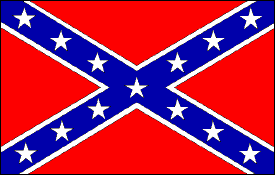 "The Confederate Battle Flag"
"The Confederate Battle Flag" - The Southern Cross
 "The Confederate Battle Flag"
"The Confederate Battle Flag"
- The Southern Cross
Confusion was caused by the commanders not being able to distinguish their troops from those of the enemy and adding to these difficulties was the fact that the "Stars and Bars" was so similar to the "Stars and Stripes" . General Beaurgard was determined to remedy the flag problem, he attempted to have the Confederate flag changed but Congressman William Porcher Miles suggested that the army adopt its own distinctive battle flag, and recommended the design he had presented to the Congress as the Confederate Flag on March 4, 1861. This flag was agreed upon but it was recommended that it would be more convenient and lighter as well as less likely to be tore by bayonets or tree branches if made square. This flag was issued in different sizes; 48 inches square for the infantry, 36 inches for the artillery, and 30 inches for the cavalry. Other flags such as State regimental colors were used by the Confederacy on the battlefield, but the Battle Flag, although it was never officially recognized by the Confederate government, came to represent the Southern "cause" to most people.
The battleflag of the famous Confederate Army of Northern Virginia was altered in the design phase in order to make it easier to manufacture.
By tradition, American flags had been rectangular in shape. The design for the ANV battleflag was originally submitted as rectangular - 12 gold stars on diagonally crossed blue bars - on a field of pink or rose (originally) - the Southern Cross. The man who came up with this design, South Carolina Congressman William Porcher Miles, had been inspired by the South Carolina secession banner that was similar but had a St. George's cross rather than a St. Andrews cross. It also had the state coat of arms in the upper left quadrant.
It was origionally planned to use versions of that secession flag for military use and to put each state's coat of arms in the upper quadrant. But Miles, who also submitted a design for a National flag to the Committee on Flag and Seal, which he chaired, decided to go with a St. George's cross instead without state coats of arms. His National design was rejected as, at the time, the Confederacy only had 7 states and the star layout looked asymmetrical. When CS Generals Beauregard, Joseph Johnston and Gustavus Smith met to create a purely military flag for the Eastern army they settled on Miles design - only after failing to get the Confederate Congress to change the First National flag - the Stars and Bars - as it looked too much like the US flag (it was an intentional copy of it).
By this time, the Confederacy consisted of 11 states (October, 1861) and had also recognized the delegation from Missouri. So the flag would have 12 stars on a rectangular field. One idea was for the flag to be blue with crossed red bars but this was shelved in favor on the more well known flag (although that pattern would show up in 1864 for Gen. John Walker's Texas Division in the Trans-Mississippi). Gen. Johnston suggested that the flag be made square rather than rectangular for two reasons: 1) to save on materials in the construction and, 2) to make it easier to manufacture. A rectangular flag of this design would have to deal with obtuse angles rather than right angles, thus slowing down the construction of the flags. This harkens back to how quilts are made - most are square and have square segments since right angles are easier to sew. Curiously, in early 1864, the battleflags for Johnston's new command, the Army of Tennessee, would receive rectangular Southern Cross flags from the Atlanta Depot - who evidently erred in making them since Johnston's orders called for "flags like those of the Virginia army." These, of course, as we now know, were square.
The first 120 silk battleflags were issued in November, 1861. They had 12 gold painted stars on blue bars edged with white on fields of pink or rose. The exterior borders of the flags were yellow. The materials used were dress silk bolts purchased from Richmond area merchants in bulk. The hoist edge of the silk flags was blue. Since these colors were popular trim for ladies dresses (the latter red color of these flags would not be available in silk since that color was for the "ladies of the evening") they were what the later issues of this famous flag were to be. Some CS officers did not care for the colors and were told by Beauregard, in no uncertain terms to, "dye it red sir, dye it with your blood!"
This famous square battleflag would see 8 more variant issues before the end of the war: one cotton (for three brigades only including the famous Texas Brigade) and 7 wool bunting issues that varied from one to the other by sizes, star seperations and color of the exterior borders. These latter variants were all the deep red color that we now know best.
Most folks west of the Appalachians never knew about the ANV pattern flags - for the western troops had created their own distinctive battle flags to use. It was in the 1905 UCV booklet that put the stamp on the ANV flag as what has come to be known today as "the battleflag". No one single flag can make that claim.
![]()